
Ormskirk is a market town in the West Lancashire district of Lancashire, England. It is located 13 miles (21 km) north of Liverpool, 11 miles (18 km) northwest of St Helens, 9 miles (14 km) southeast of Southport and 18 miles (29 km) southwest of Preston. Ormskirk is known for its gingerbread. In 2011 it had a population of 24,073.
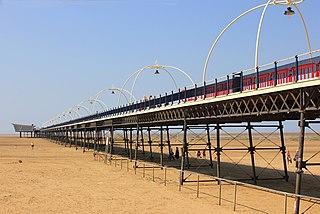
Southport is a seaside town in the Metropolitan Borough of Sefton in Merseyside, England. It lies on the West Lancashire coastal plain and the east coast of the Irish Sea, approximately 17 miles (27 km) north of Liverpool and 15 miles (24 km) southwest of Preston. At the 2021 census, Southport had a population of 94,421, making it the eleventh most populous settlement in North West England and the third most populous settlement in the Liverpool City Region.

Lytham St Annes is a seaside town in the Borough of Fylde in Lancashire, England. It is on the Fylde coast, directly south of Blackpool on the Ribble Estuary. The population of the built-up area at the 2021 census was 42,695. The town is made up of the four areas of Lytham, Ansdell, Fairhaven and St Annes-on-the-Sea.

Scarisbrick is a village and civil parish in West Lancashire, England. The A570, the main road between Ormskirk and Southport, runs through Scarisbrick, and much of the village lies along it. As a result, it does not have a traditional village centre, though the junction with the A5147 is close to the geographic centre.

Scarisbrick Hall is a country house situated just to the south-east of the village of Scarisbrick in Lancashire, England. It is currently home to Scarisbrick Hall School.
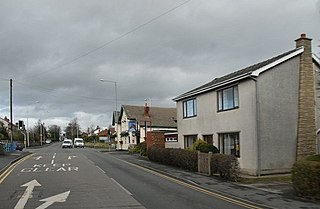
Euxton is a village and civil parish of the Borough of Chorley, in Lancashire, England. The population of the civil parish as taken at the 2011 census was 9,993, however, the population is now estimated to be around 14,000 due to the increase in housing developments in the village, including the Buckshaw development. The village is situated just to the west of Chorley, and to the south of Clayton-le-Woods.

Bescar Lane railway station is on the Manchester to Southport Line, 4.5 miles (7.2 km) east of Southport in the village of Scarisbrick. Bescar Lane is an old cottage-style station, operated by Northern Trains. Its remote location, some distance from the centre of Scarisbrick Parish, is considered to be "problematic".

Eccleston is a civil parish in the Metropolitan Borough of St Helens, Merseyside, England. At the 2011 census, it had a population of 10,433.

Edward Welby Pugin was an English architect, the eldest son of architect Augustus Welby Northmore Pugin and Louisa Barton and part of the Pugin & Pugin family of church architects. His father was an architect and designer of Neo-Gothic architecture, and after his death in 1852 Edward took up his practice. At the time of his own early death in 1875, Pugin had designed and completed more than one hundred Catholic churches.

North Meols is a civil parish and electoral ward in the West Lancashire district of Lancashire, England. The parish covers the village of Banks and the hamlet of Hundred End. The population of the parish/ward at the 2011 census was 4,146. Historically the parish covered a wider area including much of what is now Southport.

Banks is a large coastal village in the civil parish of North Meols, in the West Lancashire district, in Lancashire, England, south of the Ribble estuary four miles (6 km) north-east of Southport town centre. In 2021 it had a population of 4430. It is in the Southport parliamentary constituency.
The Priory Estate is a housing estate in Dudley, West Midlands, England, which has largely been developed since 1929.
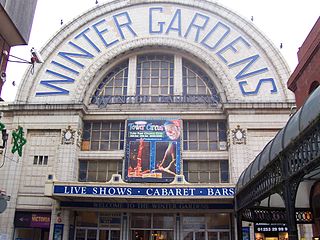
The Winter Gardens is a large entertainment complex in Blackpool, Lancashire, England, which includes a theatre, ballroom and conference facilities. Opened in 1878, it is a Grade II* listed building, operated by Blackpool Entertainment Company Limited on behalf of Blackpool Council, which purchased the property from Leisure Parcs Ltd as part of a £40 million deal in 2010.
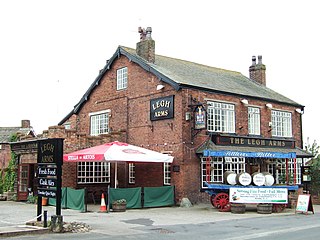
Mere Brow is a small village in Lancashire, England, situated between Tarleton and Banks, just off the A565 road. It is 6 miles (9 km) east of Southport and 10 miles (15 km) south west of Preston. It is administered by the West Lancashire Borough Council and the Tarleton parish council. It is in the West Lancashire parliamentary constituency. Mere Brow is the second largest village in the parish of Tarleton, the largest being Tarleton and the smallest being Holmes and Sollom.
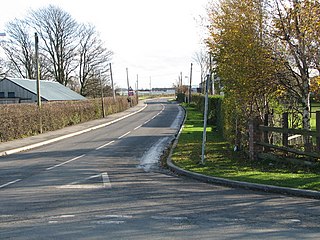
Hundred End is a coastal hamlet in West Lancashire, England. It is 2 miles east of the larger village of Banks and 2 miles west of the larger village of Hesketh Bank.
The Friends of Bank Hall is the new charitable name for the former Bank Hall Action Group who are a voluntary group which aims to raise public awareness and secure the future restoration of Bank Hall, a Jacobean mansion house and gardens, near the banks of the River Douglas, in Bretherton, Lancashire.

Bank Hall Gardens comprise 18 acres (73,000 m2) of curtilage at Bank Hall, in Bretherton, Lancashire, England. The gardens contain specimen trees including a yew thought to be the oldest in Lancashire. Many architectural features, statues, low garden walls, conservatory and greenhouses have gone but there are plans to recreate them. The Bank Hall Action Group has tended the grounds since its formation in 1995. The group has planted specimen trees and identified the flora and fauna. The group opened the gardens to the public in 1999 after building a security fence, erecting scaffolding to secure the building and clearing the overgrowth. New varieties of snowdrops, some of which are unique to the gardens were uncovered. After a visit from the Snowdrop Society in 2007 the garden has become nationally known for snowdrop carpets during February.
The Bank Hall Estate is the demesne of the Jacobean mansion house of Bank Hall, including much of land around the village of Bretherton, which is owned by the Lilford Trust.

Scarisbrick Hall School is a mixed private school, located in Scarisbrick Hall, Lancashire, England, that educates children from nursery to age 18.

Maxwell and Tuke was an architectural practice in Northwest England, founded in 1857 by James Maxwell in Bury. In 1865 Maxwell was joined in the practice by Charles Tuke, who became a partner two years later. The practice moved its main office to Manchester in 1884. Frank, son of James Maxwell, joined the practice in the later 1880s and became a partner. The two senior partners both died in 1893, and Frank Maxwell continued the practice, maintaining its name as Maxwell and Tuke.



















